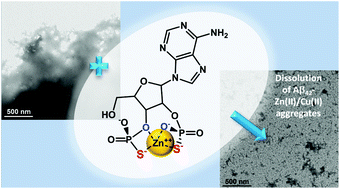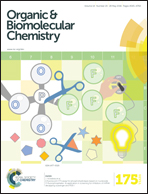Nucleoside-2′,3′/3′,5′-bis(thio)phosphate antioxidants are also capable of disassembly of amyloid beta42-Zn(ii)/Cu(ii) aggregates via Zn(ii)/Cu(ii)-chelation†
Abstract
Currently, there is an urgent need for biocompatible metal-ion chelators capable of antioxidant activity and disassembly of amyloid beta (Aβ)-aggregates as potential therapeutics for Alzheimer's disease (AD). We recently demonstrated the promising antioxidant activity of adenine/guanine 2′,3′ or 3′,5′-bis(thio)phosphate analogues, 2′-dA/G3′5′PO/S and A2′3′PO/S, and their affinity to Zn(II)-ions. These findings encouraged us to evaluate them as agents for the dissolution of Aβ42-Zn(II)/Cu(II) aggregates. Specifically, we explored their ability to bind Cu(II)/Zn(II)-ions, the geometry and stoichiometry of these complexes, Cu(II)/Zn(II)-binding-sites and binding mode, and the ability of these analogues to dissolve Aβ42-Zn(II)/Cu(II) aggregates, as well as their effect on the secondary structure of those aggregates. Finally, we identified the most promising agents for dissolution of Aβ42-Zn(II)/Cu(II) aggregates. Specifically, we observed the formation of a 1 : 1 complex between 2′-dG3′5′PO and Cu(II), involving O4 ligands. Zn(II) was coordinated by both thiophosphate groups of 2′-dA3′5′PS and A2′3′PS involving O2S2 ligands in a 1 : 1 stoichiometry. A2′3′PS dissolves Aβ42-Zn(II) and Aβ42-Cu(II) aggregates as effectively as, and 2.5-fold more effectively than EDTA, respectively. Furthermore, 2′-dG3′5′PS and A2′3′PS reverted the Aβ42-M(II) structure, back to that of the free Aβ42. Finally, cryo-TEM and TEM images confirmed the disassembly of Aβ42 and Aβ42-M(II) aggregates by A2′3′PS. Hence, 2′-dG3′5′PS and A2′3′PS may serve as promising scaffolds for new AD therapeutics, acting as both effective antioxidants and agents for solubilization of Aβ42-Cu(II)/Zn(II) aggregates.


 Please wait while we load your content...
Please wait while we load your content...